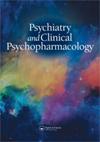百里醌(TQ)通过对Aβ(1-42)灌注的老年痴呆症大鼠模型的抗炎作用证明其神经保护作用
IF 0.6
4区 医学
Q4 PHARMACOLOGY & PHARMACY
引用次数: 11
摘要
摘要目的:阿尔茨海默病(AD)是一种严重的神经退行性疾病,表现为神经元死亡、记忆丧失和认知能力下降。神经炎症与阿尔茨海默病之间的关系已被充分证实。然而,AD患者抗炎治疗的选择非常有限。先前的研究表明,黄酮类化合物可能是一种有效的治疗方法,而在黑草中发现的芳香烃百里醌(TQ)因具有很强的抗炎作用而被认为是候选分子。本研究旨在探讨TQ对Aβ(1-42)输注大鼠AD模型的神经炎症和神经保护作用。方法:以6月龄大鼠(n = 23)为研究对象,通过含有聚集的Aβ(1-42)的微渗透泵在海马内灌注14 d,建立AD大鼠模型。造模后,以20 mg/kg/天的剂量灌胃TQ 15 d。通过Morris水迷宫任务测量记忆巩固来确定功能恢复。采用磁性荧光法检测大鼠海马组织中肿瘤坏死因子-α (TNF-α)、白细胞介素-1β (IL-1β)、白细胞介素-1α (IL-1α)和干扰素-γ (IFN-γ)的含量。为了揭示TQ给药后海马组织功能分子的变化,采用Western blotting分析神经元迁移蛋白双皮质素(DCX)、突触可塑性标志物丝裂原活化蛋白激酶2 (MAP2)和凋亡相关蛋白聚(adp -核糖)聚合酶(PARP)的蛋白表达谱。结果:Aβ(1-42)输注组在第4天的记忆表现较假性对照组差,TQ改善了这一行为。在我们的研究中,TNF-α、IL-1α和IL-1β的水平在各组之间没有明显变化。另一方面,与假对照组相比,Aβ(1-42)输注使IFN-γ水平略有降低。TQ治疗改善了受损的记忆表现和IFN-γ水平。结果发现,与假对照组相比,TQ治疗增加了DCX蛋白水平。与假对照组相比,a β(1-42)组和a β(1-42)+TQ组的MAP2水平和PARP蛋白活性均显著降低。Pearson相关检验显示,a β(1-42)组IL-1β与DCX呈正相关。讨论:我们的数据表明,在Aβ(1-42)输注的AD大鼠模型中,tq相关的功能改善可能是由于神经发生水平的增加和IFN-γ水平的改善。本文章由计算机程序翻译,如有差异,请以英文原文为准。
Thymoquinone (TQ) demonstrates its neuroprotective effect via an anti-inflammatory action on the Aβ(1–42)-infused rat model of Alzheimer's disease
ABSTRACT OBJECTIVES: Alzheimer’s disease (AD) is a severe neurodegenerative disease with presentation of the neuronal death, memory loss and cognitive decline. The relationship between neuroinflammation and AD has been well documented. However, the options of anti-inflammatory treatment are very limited in patients with AD. Previous studies showed that flavonoids might be an effective treatment and thymoquinone (TQ), an aromatic hydrocarbon found in Nigella sativa suggested as a candidate molecule due to having strong anti-inflammatory effects. Our study aimed to investigate the effects of TQ on neuroinflammation and neuroprotection in Aβ(1–42) infused rat model of AD. METHODS: A rat model of AD was established in 6 month-old rats (n = 23) by intra-hippocampal infusion during 14 days via a micro-osmotic pump containing aggregated Aβ(1–42). After model establishment, TQ at a dosage of 20 mg/kg/day was intubated intragastrically for 15 days. The functional recovery was determined using the Morris Water Maze task by measuring memory consolidation. The content of cytokine levels of Tumour Necrosis Factor-alpha (TNF-α), Interleukin-1 beta (IL-1β), Interleukin-1 alpha (IL-1α) and Interferon-gamma (IFN-γ) in the hippocampus was assessed by Magnetic Luminex assay. In order to reveal the functional molecular changes in hippocampal tissue upon TQ administration, the protein expression profile of neuronal migration protein Doublecortin (DCX), synaptic plasticity marker Mitogen Activated Protein Kinase2 (MAP2) and apoptosis related protein Poly (ADP-ribose) Polymerase (PARP) was analyzed by Western blotting. RESULTS: Aβ(1–42) infused group had worse memory performance than sham control group on Day 4 with an amelioration in this behaviour by TQ. In our study, the levels of TNF-α, IL-1α and IL-1β did not significantly alter among groups. On the other hand, Aβ(1–42) infusion slightly decreased the level of IFN-γ compared to sham control group. TQ treatment ameliorated both impaired memory performance and IFN-γ levels. It was found that TQ treatment increased the protein levels of DCX compared to the sham control group. Also, the levels of MAP2 and the activation of PARP protein markedly decreased in both Aβ(1–42) and Aβ(1–42)+TQ groups compared to the sham control groups Pearson’s correlation test showed a positive relation between IL-1β and DCX in the Aβ(1–42) group. DISCUSSION: Our data suggested that TQ-related functional improvement might result from the increasing level of neurogenesis and ameliorating the level of IFN-γ in the Aβ(1–42) infused rat model of AD.
求助全文
通过发布文献求助,成功后即可免费获取论文全文。
去求助
来源期刊

Psychiatry and Clinical Psychopharmacology
Medicine-Psychiatry and Mental Health
CiteScore
1.00
自引率
14.30%
发文量
0
期刊介绍:
Psychiatry and Clinical Psychopharmacology aims to reach a national and international audience and will accept submissions from authors worldwide. It gives high priority to original studies of interest to clinicians and scientists in applied and basic neurosciences and related disciplines. Psychiatry and Clinical Psychopharmacology publishes high quality research targeted to specialists, residents and scientists in psychiatry, psychology, neurology, pharmacology, molecular biology, genetics, physiology, neurochemistry, and related sciences.
 求助内容:
求助内容: 应助结果提醒方式:
应助结果提醒方式:


